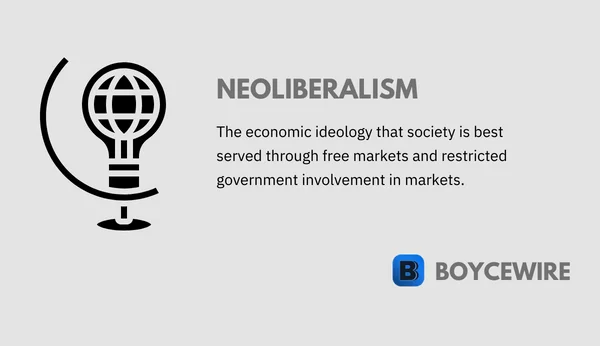Neoliberalism: Definition, Pros, Cons & Characteristics

What is Neoliberalism
Neoliberalism refers to the resurgence of free market ideas that characterized classical liberalism in the 19th century. It is based on the idea of economic freedom and limited government involvement in economic interactions between individuals.
Neoliberalism is very similar to classical liberalism. Both ideologies believe in privatization, deregulation, globalization, free trade, and limited government. However, neoliberalism differs in two key aspects. First of all, the idea covers the belief that monetary policy should be governed by a central bank. That means the central bank can decide how much money is in circulation and at what the interest rates should be.
Second of all, the idea covers the belief that the private charity is no longer sufficient to support the poor. It is therefore believed that government welfare is necessary, although in a far more limited amount than we see present today.
Key Points
- Neoliberalism is very similar to classical liberalism and free market ideology, but believes in central control of monetary policy and a small welfare state.
- Neoliberalism is characterized by the belief in privatization, deregulation, small government, free trade and globalization.
History of Neoliberalism
The origins of neoliberalism stem from the consequences of the Great Depression of 1929. In the aftermath, the popularity of free-market policies started to diminish, whilst the popularity of market control increased. The Depression was blamed on businesses and the free market, which lead to calls to government regulation and in some cases, ownership.
Classical liberalism developed as a result and shifted towards neoliberalism. There was still the belief that free markets worked, but required more government intervention that the ‘laissez-faire’ approach of classical liberalism. However, neoliberalism was largely in the shadow of Keynesian economics which flourished in the years following the Second World War.
Under Keynesian policy, government spending increased and monetary policy was loosened. That meant lower interest rates, with central banks ‘printing’ and injecting money into the economy. The aim of the central bank was to ensure full employment, but it came at a cost. By injecting money into the economy over and above the rate of economic growth, inflation was created – thereby leading to the crisis and stagflation of the 1970s and 1980s.
During this crisis, it became apparent that Keynesian economics had failed, which in turn generated a philosophical gap that would be filled by neoliberalism. Quite simply, neoliberalism believes in the idea of central banking, but that the wrong monetary policies were adopted and instead, the bank should be targeting inflation instead.
Characteristics of Neoliberalism

1. Deregulation
Neoliberalism covers the belief that governments should not interfere with market mechanisms. In other words, government intervention in the market creates distortions between supply and demand. This can lead to an undersupply of resources in some cases, whilst an oversupply in others.
By deregulating the market, neoliberals believe that the invisible hand will create positive outcomes for the economy. For instance, neoliberals believe that the minimum wage does more harm than good to low wage workers. It makes workers with a job better off, whilst preventing low skilled workers in – thereby benefiting those who already have a job.
2. Free Trade
Free trade is another key characteristic of neoliberalism. Through free trade, each country can trade which each other at no additional cost, thereby benefiting from each nation’s comparative advantage. For example, Brazil is known for its Banana’s, whilst France is known for its wine and Belgium for its chocolate.
Imposing tariffs and other trade barriers make goods more expensive for those implementing them. Neoliberalism believes that free trade makes it cheaper to buy goods abroad, but also that it is of mutual benefit.
In today’s age, it may seem that free trade is taking jobs away from one country and handing them to another. However, neoliberals believe that the shift in jobs is short-lived as consumers are paying less for goods and services, which can in turn be used to pay for other goods whereby employment can be created. At the same time, it generates an increase in demand from nations abroad as their products are equally cheaper.
3. Independent Central Banking
Neoliberalism covers the belief that government should have minimal influence over the economic interactions of individuals. By extension, this includes the supply of money. So instead of this being conducted and controlled by the government, it is organized through an independent central banking system. In doing so, the control of the money supply is free from political interference. For example, an incumbent government may increase the money supply to artificially boost the economy and employment in order to gain votes.
By maintaining independent control, the central bank is able to avoid political manipulation. With the money supply controlled by a central bank, it allows for a coordinated effort that is more efficient than allowing individual banks free reign. The rapid and unpredictable fluctuations caused by individual banks creating money produces an unstable economic environment. So by controlling the supply of money centrally, it is able to better manage the economy.
4. Privatization
As with classical liberalism, Neoliberalism covers the belief that privatization of markets produces the most optimal outcomes. This stems from the view that public ownership of resources is inefficient.
As public companies are not restricted by profit and loss, they are able to continue in business despite losing millions. Yet the same luxury would not be afforded to a private business. By allowing the privatization of firms, it will weed out inefficient businesses and leave only the most effective standing – thereby maximizing economic output.
5. Small Government
Neoliberalism stems from the belief in freedom of the individual and the power of markets. By regulating markets, it takes that freedom away. For instance, occupational licensing prevents and deters people from pursuing their desired profession. In turn, these policies restrict competition in the market place, thereby reducing freedom of choice to the consumer.
Maximizing consumer choice is not the only concern of neoliberalism. It is also concerned with the huge levels of government spending. This stems from the belief that governments spend the taxpayer’s money inefficiently. So whilst spend an extra $1 billion in education can improve results – it is not spent wisely under government. In turn, neoliberalism believes that government involvement is inefficient so should be minimized.
Benefits of Neoliberalism

1. Economic Efficiency
The argument behind neoliberalism is that government is inherently inefficient. It is inefficient in the sense that it cannot go out of business. Whilst a business that makes a consistent loss would go bust – the government carries on. Most governments maintain a budget deficit in the millions, spending more than it receives, yet it is able to carry on. This only helps finance unreliable government companies such as USPS that do not face an existential threat through the profit and loss mechanism.
Companies that make a profit are largely efficient, whilst those that make a loss are not and will go out of business. By reducing the role of government, markets are able to weed out the inefficient companies, whilst allowing those that produce a good at a reasonable price, to succeed.
2. Cheaper Goods
Neoliberalism believes in free markets and free trade between nations. That means lower trade barriers such as tariffs and quotas which make goods more expensive. By reducing trade barriers, the consumer pays a lower amount than dictated by the import tariff. At the same time, by allowing foreign goods into the country, a greater level of competition is created. This increased level of competition puts pressure on firms to reduce prices and increase efficiency in order to compete against a wider range of firms.
3. Lower Taxes
The idea behind neoliberalism is to reduce the influence and role of government. This means lower levels of government spending and fewer government departments. In turn, this reduces the need for such high levels of taxation. For instance, if the size of government could be reduced in half, then taxes could also follow suit. This would then give the individual the freedom to choose where they would like to spend their income. In doing so, we are able to achieve a greater level of utility as our income is directed to areas that maximize our happiness and enjoyment.
4. Higher Levels of Investment
With lower levels of government regulation and taxation, it incentivizes companies to invest – both from foreign as well as domestic firms. This is because the benefits the firm receives is much higher. So if it makes an additional profit of $1 million, it is able to keep more of this than if taxes were double. This, therefore, creates an incentive for businesses to improve on their efficiency and invest in new and more productive equipment. At the same time, the presence of foreign competition forces companies to become more efficient else go out of business. All of which require investment.
Criticisms of Neoliberalism

1. One Size Fits All
Part of the criticisms of neoliberalism is the idea that markets and the profit motive are efficient and create a net benefit to society. However, there are markets that create positive externalities above its true cost. For instance, education and healthcare can cost the government billions but create external benefits in the form of healthier and more intelligent citizens. If these were left up to the free market, then they would be undersupplied as they do not create a profit. This is because the free market fails to consider external benefits. For instance, if the consumer does not value education at $3,000 then the transaction is not made – even though the net benefit to society is worth $10,000.
2. Displaced Workers
Neoliberalism believes in free trade and globalization which can create worker displacement in the short-term. However, manufacturing workers across the developed world have lost out as their jobs have been moved the countries with cheaper labour. This has put many in a difficult position – particularly those in later life who will find it difficult to adjust to a new role.
3. Lower Wages
One of the biggest criticisms of neoliberalism is its belief in globalization. Yet whilst globalization may be beneficial in the long-term, it has created short-term issues. One of those issues is increased competition in the labour market. Some jobs that are required locally are not necessarily faced with the same pressures. For instance, retail worker’s jobs cannot be shipped abroad, whilst manufacturing jobs can. Yet this has led to a suppression of wages as workers are not only facing competition by local labourers, but also those halfway across the world.
4. Financial Instability
Neoliberalism may have created a period by which capital flows relatively quickly and freely between countries. This has proven beneficial to many – especially those in the developing world. However, it also provides instability in the fact that those investments can leave as quickly and easily as they came in. At the same time, any issues in the financial sphere can lead to a worldwide domino effect – as we saw in 2008 during the financial crisis.
Neoliberalism vs Liberalism
Both neoliberalism and liberalism believe in freedom and equality. However, whilst neoliberalism believes in equal opportunity, liberalism believes in equal outcomes. So whilst neoliberalism believes each individual should receive an education, liberalism believes that those who go on to succeed should subsidize those who have not.
Many will benefit from the education they receive as a child, thereby going on to earn millions. However, liberalism believes that those who go on to make millions and billions should be taxed a large sum in order to help sustain those at the bottom. By contrast, neoliberalism believes in the individual and incentives. If we are to take money away from the successful and rich, then nobody would have the incentive to work hard and achieve the same goal.
Related Topics
FAQs on Neoliberalism
Neoliberalism is the idea of limited government intervention and free-markets, but alongside a small welfare state to support those who are unable to work. Key characteristics include – privatisation, globalisation, deregulation, small government, and independent central banking.
In the 1980s, both the UK and the US took a turn towards privatisation and globalisation. However, the number of regulations has actually increased alongside government spending. So whilst poverty and inequality may have increased, these countries have not adopted true neoliberalism.
Liberalism believes in equality of outcomes, whilst neoliberalism believes in equality of opportunity.
About Paul
Paul Boyce is an economics editor with over 10 years experience in the industry. Currently working as a consultant within the financial services sector, Paul is the CEO and chief editor of BoyceWire. He has written publications for FEE, the Mises Institute, and many others.

Further Reading
 Why is Communism Bad - Critics of communism argue that it often leads to authoritarianism, inefficiency, lack of incentives, and human rights abuses, making it…
Why is Communism Bad - Critics of communism argue that it often leads to authoritarianism, inefficiency, lack of incentives, and human rights abuses, making it…  Gross National Income Definition - GNI, or Gross National Income, is the total value of goods and services produced by a country's residents, including income…
Gross National Income Definition - GNI, or Gross National Income, is the total value of goods and services produced by a country's residents, including income…  The Consequences of the Industrial Revolution - The consequences of the industrial revolution were far-reaching and included technological innovation, urbanization, labor exploitation, environmental degradation, social changes, and…
The Consequences of the Industrial Revolution - The consequences of the industrial revolution were far-reaching and included technological innovation, urbanization, labor exploitation, environmental degradation, social changes, and… 
